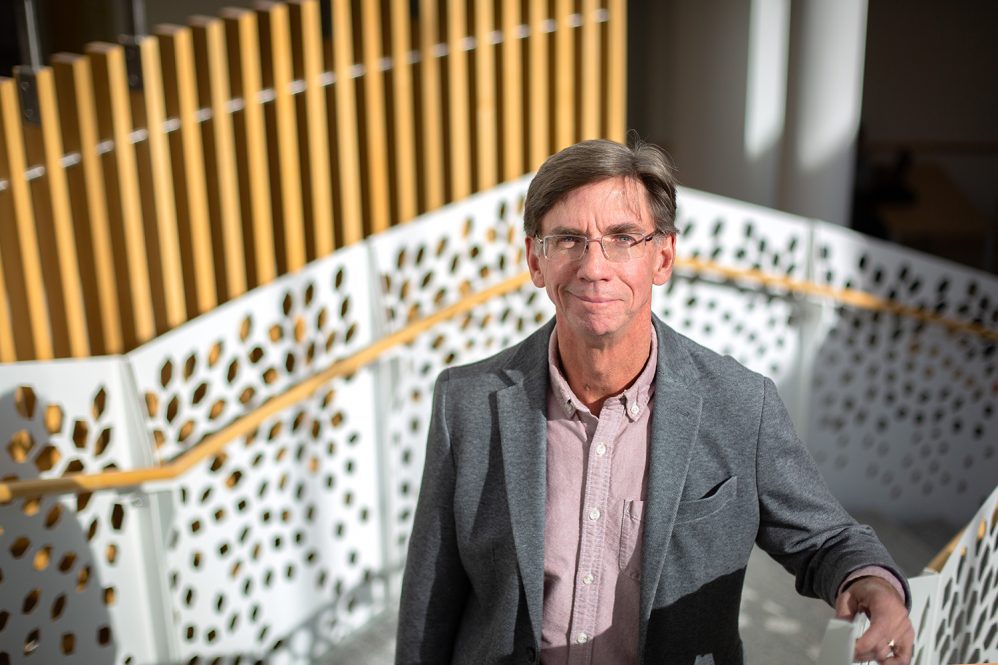How has the department changed since you joined?
I arrived in 1993, more than 30 years ago. When I got here, I was impressed with how many stellar researchers we had. And over time, that quality hasn’t changed. As science and physics have changed, we’ve changed and adapted.
In the last few years we’ve had the major renovation of the Gant building complex. We opened a brand new building right before the pandemic! But we’re very happy with the result. The renovation of the teaching labs for studio physics is wonderful. It’s very rare that a department can implement a radically new teaching method, because it requires new space, all new equipment, et cetera. The upper division teaching labs are also better equipped and organized. It’s brightly lit and well organized, a welcoming space.
How do you teach physics to non-physics majors?
It’s a challenge to have students in physics for just one semester. I think it’s more about engaging and inspiring them. So, I hit upon music as a common language. You don’t usually ask people: “Do you like music?” You ask: “What kind of music do you like?” I started a gen-ed course on physics of music, and actually won a CLAS Teaching Award for it.
Music also inspired and pushed physics forward. The mathematician Pythagoras was one of the first to analyze musical notes with math, and he developed the musical scale. He found an order to the notes, so it turned out you could use math and integers for something useful.
People’s preconceived notions about physics are that it’s all about mechanics, and it’s difficult – which gives us a bad reputation. But people’s preconceived notions about music are pretty good. I just need to fill in the gaps and show how tone quality is based on physics, for example.
What’s one thing you’d like students to know about your department?
There are a lot of opportunities for students in our department. You can get into the laboratory and do research, and we’re developing a great community of undergraduates. Our academic advisor, Micki Bellamy, has a lot to do with creating that community.
We also are having record-setting research years, which creates great opportunities for graduate students.
And finally, people are just doing incredible things here. It was exciting and humbling to read the promotion files [for faculty applying for tenure and promotion]. From early to mid-career to full professors, everyone is doing amazing things.
Tell us about your research.
I work in laser physics, and over the last few decades, there have been efforts to make laser pulses shorter in time. It’s like using a camera – if you have a slow shutter speed, your picture might be blurry, but faster speeds make for sharper images. There are lasers at the micro, nano, pico, and femtosecond scales. I have a femtosecond laser [that pulses at one quadrillionth of a second]. Some people have attosecond lasers [that strobe at one quintillionth of a second]. While it’s on, because it’s so fast, it’s delivering power on the order of the entire U.S. electrical grid.
One reason to learn how they work is to learn about photosynthesis in plants. The primary steps in photosynthesis are on femtosecond scale. So, what happens to that energy? Where does it go? You might think that reactions that fast would heat up the plant. But plants are annoyingly efficient.
Professor Carlos Trallero has a much newer laser than mine, with a higher average power. We’re working together on trace molecule detection in biological samples — we can harness the laser to help us detect and identify unknown molecules.
What’s one goal you have for the Department of Physics?
It’s an exciting time in the department. We have 32 faculty members, and each area has something really interesting going on.
Our astronomers were among the first to get research time on the new James Webb telescope. We have a joint NSF-funded initiative with Yale, called Quantum CT, which brings partners from business, academia, government, and nonprofits together to develop quantum capabilities in the state. Some of our nuclear physicists are working with the Facility for Rare Isotope Beams at Michigan State and on the development of a new nuclear accelerator at Brookhaven National Laboratory. And the particle physics group is working with the Muon G-2 collaboration on more precise measurements of [short-lived particles known as] muons.
In recent years we also completely changed the way we teach introductory physics, using the studio physics teaching model. That redesign has improved the experience for students and professors. We are also working to introduce quantum mechanics earlier in the program so that students can get involved in the Quantum CT initiative.
Everything’s going quite well. So, I want to keep things going.
Where do you see the department going in the next 10 years?
Quantum physics is going to keep growing, and NSF is funding big quantum projects. If we can keep that momentum and get further funding, that would be big for us and the state. Here at UConn, we recently re-opened an observatory on campus, the East Road Observatory. We may be able to see exoplanets [planets that orbit other stars] from our little observatory.
What’s your favorite place on campus?
When the weather is nice, I like to have lunch on the Student Union Terrace — I like to sit out there and talk to my students, with people coming and going. It’s just lovely out there.



